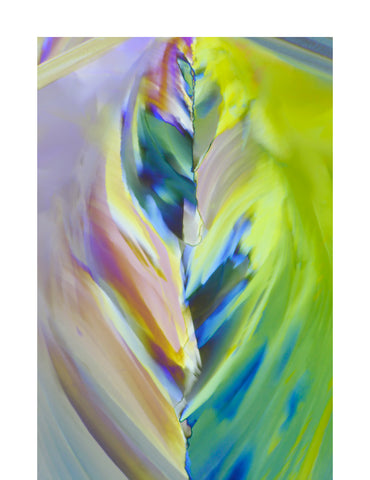
SERENADE -Photograph of crystalline tartaric acid found in wine.
NEWS FROM THE STUDIO/LAB:
After a cool and wet winter (by Arizona standards, anyway) the sunshine and warm weather have returned to the southwest. All those rainy days we sat through at the Arizona Fine Art Expo have created a desert bloom the likes of which have not been seen here in many years. So in tribute, I'm including three new crystal images that seem to fit a flowering motif in this issue of my newsletter. A new crystalline subject, malic acid which is found in wine, makes its debut.
Cheers!
- Lee
April 2023

SUMMER BREEZE -Photograph of crystalline malic acid found in wine. -NEW!
"Nature does not create works of art. It is we, and the faculty of interpretation peculiar to the human mind, that see art." Man Ray -artist, photographer

REVERIE -Photograph of crystalline tartaric acid found in wine.
ART AND SCIENCE:
Recollections of High School Physics
During my junior year in high school I carried Berenice Abbott's photo with me most everywhere I went. It wasn't that Berenice and I were close or anything, and to be more precise, it wasn't a photo of Berenice that I carried, but rather a photo by Berenice. Her photograph, Bouncing Ball in Diminishing Arcs, graced the front cover of my high school physics textbook, wonderfully illustrating through the use of time-lapse stroboscopic imaging the trajectory of a bouncing ball.

From 1958 to 1960, Berenice Abbott produced a whole series of photographs for the Massachusetts Institute of Technology's Physical Science Study Committee Project, whose aim was to improve secondary school physics teaching.
Many years before, Abbott, a decidedly avant-garde artist, had penned a "manifesto" entitled Photography and Science. In it, she said "We live in a world made by science. There needs to be a friendly interpreter between science and the layman. I believe photography can be this spokesman, as no other form of expression can be." She was to prove herself to be an eloquent spokesperson, indeed.

Abbott's artistic and photographic journey began at the age of 17 when she left a difficult home life for New York City to pursue a career as a painter and sculptor. A move to Paris followed and led to a job as a darkroom assistant for the legendary surrealist artist and photographer Man Ray.
She knew nothing about photography at the time but began taking her own photos with a camera borrowed from her employer. Photography was to become her passion. Later, she wrote: "I took to photography like a duck to water. I never wanted to do anything else."
She returned to NYC in the early 1930s and began a lifelong career of authoring, editing and contributing to photographic publications. Her list of accomplishments is wider ranging than almost anyone else’s in the history of American photography. A true pioneer in the field she was inducted into the International Photography Hall of Fame and Museum in 2000.
Although Abbott's work remains largely unknown today (she was not even given photo credit for all those images in my textbook), I recall her photos well and am happy to shine a little light on her wonderful contributions to science, art, and photographic history.



